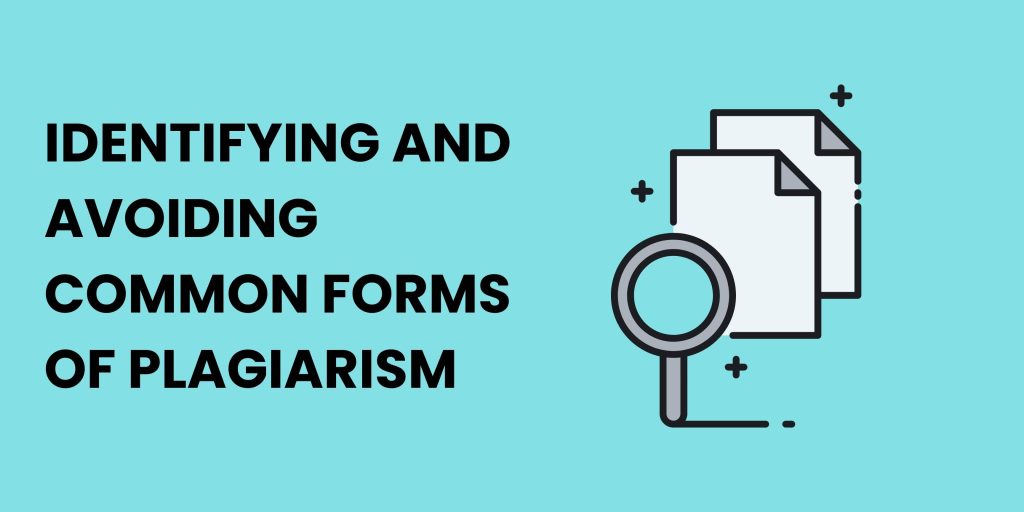Plagiarism is a serious offense that can have severe consequences on your academic and professional endeavors. It is essential to develop a clear understanding of the various forms of plagiarism to avoid unintentional plagiarism and maintain the integrity of your work. In this blog post, we will explore some common forms of plagiarism and provide you with practical tips on how to identify and avoid them. By following these guidelines, you can cultivate responsible writing practices and ensure that your work is original, credible, and ethically sound.
- Copy-and-Paste Plagiarism:
One of the most straightforward forms of plagiarism is copy-and-paste plagiarism. It involves directly copying text from a source without proper citation or attribution. This type of plagiarism is easily detectable since the copied text will appear identical to the original source. To avoid copy-and-paste plagiarism, always provide proper citation and quotation marks when using someone else’s words verbatim.
Example:
Original sentence: “The increasing dependence on smartphones has transformed the way people communicate.”
Copy-and-paste plagiarism: The increasing dependence on smartphones has transformed the way people communicate.
Avoiding copy-and-paste plagiarism: According to Smith (2020), “The increasing dependence on smartphones has transformed the way people communicate.”
- Paraphrasing Plagiarism:
Paraphrasing plagiarism occurs when you rephrase someone else’s ideas or information without giving proper credit to the original source. Even if you rewrite the text in your own words, failing to provide proper citation can still be considered plagiarism. To avoid paraphrasing plagiarism, ensure that you accurately convey the author’s ideas in a new and original way, and include an appropriate in-text citation or a footnote to acknowledge the source.
Example:
Original sentence: “Climate change poses a significant threat to global ecosystems.”
Paraphrasing plagiarism: Global ecosystems are at risk due to climate change.
Avoiding paraphrasing plagiarism: According to Johnson (2019), climate change represents a significant threat to global ecosystems.
- Self-Plagiarism:
Self-plagiarism occurs when you present your own previously published work as new and original without proper acknowledgment. While it may seem acceptable to reuse your own work, it is important to recognize that each publication should contribute fresh insights and knowledge. To avoid self-plagiarism, clearly indicate any material that has been previously published and provide proper citation to your own work.
Example:
Imagine you previously wrote an article on the topic of renewable energy and are now writing a new article for a different publication. You want to include a section from your previous article without proper acknowledgment.
Self-plagiarism: Incorporating the exact section from your previous article without citing it as your own work.
Avoiding self-plagiarism: According to the author’s previous publication (Doe, 2021), “Renewable energy sources have gained significant attention in recent years.”
- Patchwriting:
Patchwriting refers to a form of plagiarism where you borrow phrases, sentences, or paragraphs from a source and slightly modify them while retaining the original structure and meaning. It can be an attempt to disguise plagiarism but is still considered an infringement of intellectual property rights. To avoid patchwriting, ensure that you always express ideas in your own words and provide proper citation to the original source.
Example:
Original sentence: “Artificial intelligence has the potential to revolutionize various industries, including healthcare and finance.”
Patchwriting plagiarism: Artificial intelligence has the potential to bring about a revolution in numerous sectors, such as healthcare and finance.
Avoiding patchwriting plagiarism: As noted by Thompson (2018), artificial intelligence has the potential to revolutionize various industries, including healthcare and finance.
- Verbatim Plagiarism:
Verbatim plagiarism occurs when you directly quote from a source without using quotation marks or providing proper citation. This type of plagiarism misrepresents the words of the original author as your own. To avoid verbatim plagiarism, always use quotation marks to indicate a direct quote and provide an appropriate citation to the original source.
Example:
Original sentence: “Education is the passport to the future.”
Verbatim plagiarism: Education is the passport to the future.
Avoiding verbatim plagiarism: “Education is the passport to the future” (Smith, 2022).
Conclusion:
Plagiarism is a serious offense that can have severe consequences on your academic and professional journey. By familiarizing yourself with the various forms of plagiarism and implementing responsible writing practices, you can ensure the integrity of your work. Avoid copy-and-paste plagiarism by using proper citation and quotation marks, and paraphrase ideas while providing appropriate attribution. Be mindful of self-plagiarism by acknowledging previously published work. Avoid patchwriting by expressing ideas in your own words, and use quotation marks for direct quotes to avoid verbatim plagiarism. Remember, maintaining academic and professional integrity not only demonstrates your credibility but also contributes to the advancement of knowledge and the ethical conduct of research and writing.
